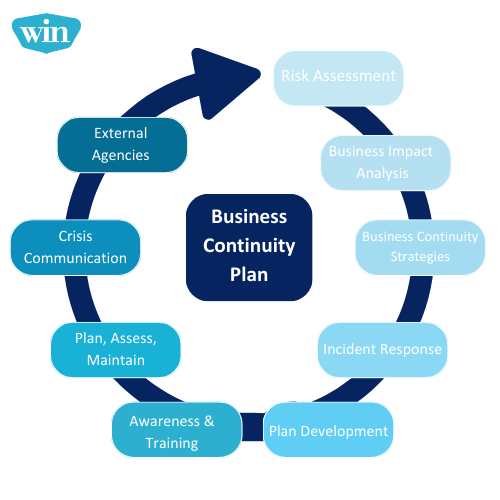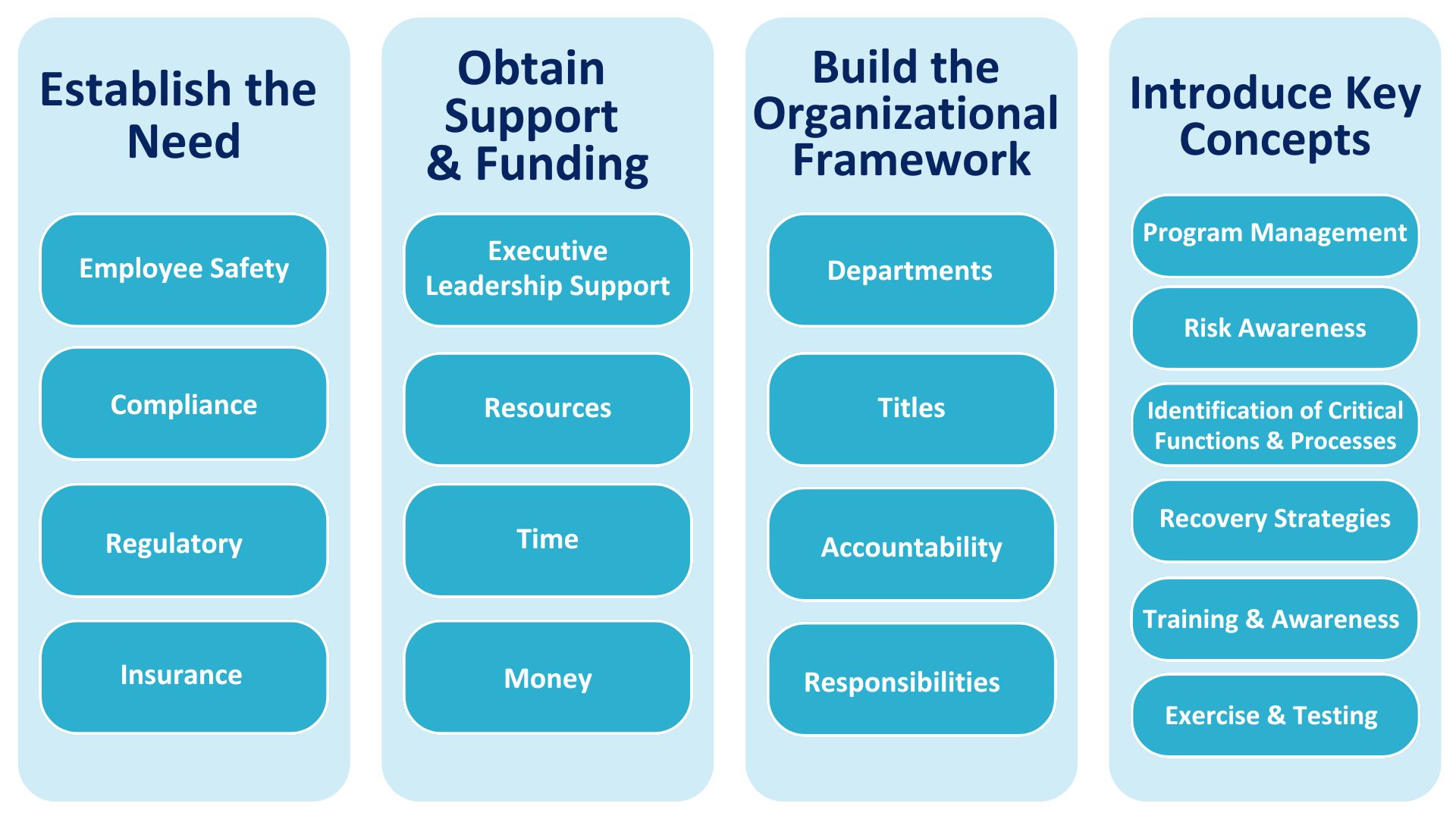In today’s constantly changing business environment, the need for effective business continuity planning (BCP) cannot be overstated. In fact, about 25% of companies that experience a disaster do not re-open (FEMA).
A business continuity plan serves as a roadmap to navigate through unforeseen disruptions, ensuring the continuity of operations and safeguarding against potential risks. In this blog post, we will:
- Define a BCP and its key components
- List the consequences of not having a BCP
- Explain the BCP process and who needs one
- Discuss its importance to the organization
- Dispel some common misconceptions about BCPs
- Provide tips on choosing the right BCP partner.
What Is Business Continuity Planning?
When it comes to business interruption, it’s not a case of whether you will have one. It’s only a matter of WHEN. You need to be prepared, and you need to have a plan for when it happens.
Business Continuity Planning is a holistic management process that identifies potential threats and their impact to an organization. It protects people, environment and property.
BCPs play a pivotal role in minimizing disruption and ensuring operational resilience. By proactively identifying risks, seeing the gaps, accepting the risk and laying out a recovery plan, you can protect your reputation, build customer trust, and maintain financial stability. Statistical evidence highlights the stark impact of disruptions on businesses without a BCP, underscoring the imperative of preparedness.
The Consequences of Not Having a Business Continuity Plan
A robust BCP can prevent businesses from significant risks and vulnerabilities. Real-world examples abound, and here are just a couple:
A break in continuity can cost $10,000/hour
Even the smallest enterprises heavily rely on data and connectivity. As a result, IT disruptions have become more expensive than ever. Just one hour of downtime can cost $10,000 for small businesses. Those hourly costs can balloon to more than $5 million for larger companies (Source: Datto)
90% of companies permanently close if they are slow to reopen
A break in continuity can end a business if they can’t restart operations quickly enough. In fact, 90% of businesses fail within a year if they can’t get back up and running within five days after a disaster. The longer recovery takes, the more likely a business will have to shut its doors permanently. (Source: FEMA)
The repercussions of not having a BCP extend beyond immediate financial losses. Businesses may experience prolonged downtime, leading to customer dissatisfaction and loss of market position. Disruptions can also have a ripple effect on stakeholders, including employees, customers, and suppliers, which may impact long-term sustainability.
A BCP encompasses several key components, including:
- Program Initiation & Management: Establishing and overseeing the framework, development and maintenance of the BCP.
- Risk Assessment: Identifying and analyzing potential threats, vulnerabilities, and their impacts on business operations.
- Business Impact Analysis: Evaluating the effects of disruptions on critical business functions and prioritizing recovery efforts.
- Business Continuity Strategies: Developing and implementing plans and procedures to ensure continuity of essential operations during disruptions.
- Incident Response: Executing predefined actions to address and manage disruptions promptly as they occur.
- Plan Development & Implementation: Creating detailed continuity plans and putting them into action to minimize downtime and losses during disruptions.
- Awareness & Training Programs: Educating employees about their roles and responsibilities in executing the business continuity plan and providing training to enhance their preparedness.
- Business Continuity Plan Exercise, Assessment & Maintenance: Testing the effectiveness of the continuity plan through simulations, evaluating its performance, and making necessary adjustments to ensure its relevance and readiness.

Keys to BCP Success
To implement a successful BCP, there are four key areas to focus on for program initiation and management.

- Establishing the need: This involves conducting a thorough assessment of potential risks and vulnerabilities that could disrupt business operations. It highlights the importance of implementing a BCP to mitigate these risks and ensure organizational resilience.
- Obtain support and funding: In this stage, businesses need to secure buy-in from key decision-makers by clearly articulating the benefits of a BCP. This includes obtaining necessary financial resources to support the development, implementation, and maintenance of the plan.
- Build the organizational framework: Establishing the organizational structure and processes necessary to support the business continuity plan. This involves appointing a dedicated team or coordinator, defining roles and responsibilities, and integrating continuity procedures into existing business processes.
- Introduce key concepts: Educating employees and stakeholders about risk management, processes and communication. This ensures clear understanding and acceptance of the plan throughout the organization, fostering a culture of preparedness and resilience.
Who Needs a Business Continuity Plan?
Business continuity planning is indispensable across various sectors, including finance, healthcare, manufacturing, and IT services. While large corporations may have dedicated resources for BCPs, small and medium enterprises (SMEs) stand to benefit equally, albeit with tailored approaches.
Common Misconceptions About Business Continuity Plans
There are many misconceptions about business continuity plans. A few of them include:
- One-size-fits-all approach: This is assuming that a generic template or plan can effectively address the unique needs and risks of every organization. In reality, BCPs should be tailored to specific business processes, industry regulations, and organizational structures.
- That they’re only for large enterprises: Believing that a BCP is only necessary for large corporations with extensive resources. In fact, businesses of all sizes can benefit from having a plan in place to mitigate risks and minimize disruptions.
- Focus is solely on IT: Limiting the scope of business continuity planning to IT systems and infrastructure. While technology is a critical component, effective plans also address other aspects such as personnel, facilities, supply chain, and communication protocols.
- Relevant only for natural disasters: Assuming that BCPs are only needed for natural disasters such as earthquakes or hurricanes. While these are important considerations, plans should also account for other potential disruptions such as cyberattacks, power outages, or pandemics.
- Set-it-and-forget-it mentality: Believing that once a BCP is developed and implemented, no further action is required. Plans should be regularly reviewed, tested, and updated to remain effective in response to evolving threats and changes within the organization.
- Expensive and time-consuming: There are upfront investments involved, but the long-term benefits of minimizing downtime, protecting assets, and maintaining customer confidence often outweigh the initial costs.
How to Choose the Right BCP Partner
It can be a daunting task to develop, implement, and execute a business continuity plan. This is a big decision: the resiliency – and potentially the very existence – of your company depends on the effectiveness of your business continuity program and the partner you choose.
So, how do you select the best partner to develop a BCP for your organization? There are five essential questions you should ask any potential provider right at the start. Here they are:
1. How long have they been in business?
The first question is entirely quantifiable: how long has the service provider been in business?
Can a “young” company be a good choice? Maybe – but you need to put in the due diligence to be sure they know their stuff and are stable enough to survive. Longevity, on the other hand, brings certain benefits:
- A depth of knowledge in the field
- A breadth of experience across many companies and industries
- An increased likelihood of future stability
- Proven commitment to business resiliency services
2. What’s their reputation as a company?
This question looks at the provider’s reputation in the industry. Two key ways to examine reputation are:
- Look at the company’s website. Are there client testimonials available for review? Do they have case studies you can read? Sure, the company has handpicked these, but regardless, they do tell you if the company has satisfied customers.
- Ask your network. Chances are you know someone who has had first-hand experience with the provider. Ask for their candid feedback.
3. What is the breadth of their capabilities?
Business continuity planning must encompass many factors if it is truly going to ensure overall business resiliency. You want to be sure the provider you choose has the appropriate breadth of capabilities to deliver that resiliency.
A business continuity provider should have capabilities that address IT concerns, business processes, cyber security, and more. In essence, they should address the entire spectrum of your business.
4. Do they have a holistic resiliency mindset and approach?
When you look at a provider’s capabilities, you should also look at their mindset and approach. For instance, a provider might have an extensive menu of services, but treat them all as separate items and passively allow you to pick and choose from among them. You could conceivably “fail to sign up” for the right services for your business.
In contrast, a provider with a holistic resiliency mindset and approach will have a wide breadth of services, but couple that with the ability to put it all together with a focus on the outcomes your company needs. They will be able to help you create a business continuity program that is appropriate for your business, selecting the right mix of services and support to deliver true resiliency.
5. Are they in alignment with industry standards?
In the past several years, business continuity management has been the subject of many new and helpful standards, such as ISO 22301. Any provider you consider should be familiar with the industry standards and work in alignment with them.
If you are in an industry with unique requirements, such as HIPAA for the healthcare industry, you want a provider who can execute a business continuity plan that supports those compliance requirements.
Conclusion
BCPs are indispensable tools for any business looking to navigate uncertainties and safeguard their continuity. Organizations today must see BCPs not as an expense, but as an essential investment in their future stability and growth. By planning ahead and being prepared, businesses can increase their resilience and come out of a disruption even stronger.
Ready to Learn More?
It’s critical to assess your current BCP or begin the process of creating one if you haven’t already. We can help you explore options and get the process started. To learn more or for a complimentary consultation, talk to a WIN Specialist today.
